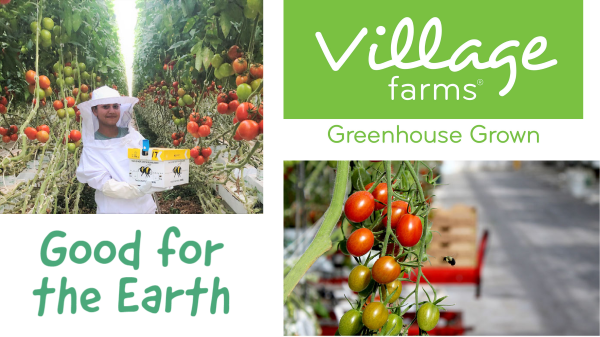Creepy crawly bugs come in all shapes and sizes in this great wide world of ours, and we know that every insect plays a part in keeping our environment in balance. In agriculture when insects are a nuisance, we call them ‘pests’, but when they are helpful, we call them ‘beneficials’.
Pesticides are used in agriculture to keep plants healthy from the pesky pests. But, did you know that beneficial insects are used in farming to reduce the need for chemical pesticides and help facilitate the healthy growth of fruits and vegetables? Integrated Pest Management (IPM) is a method that has been used with great success in reducing the need for chemicals in agriculture while working to optimize plant health.
Among Indoor farmers, especially hydroponic greenhouse growers, and more specifically high-tech Controlled Environment Agriculture (CEA), such as the type of farming Village Farms BB #:153066 growers engage, an IPM program was developed and implemented with great success in the greenhouse industry thanks in large part to the contribution of Village Farms.
Here is a bit of a story about how the good bugs fight the bad bugs, and how Village Farms was on the front lines of this from the start, fighting the good fight, and because of this, today we continue to grow healthy plants that blossom into tasty, flavorful fruits and vegetables.
 Village Farms’ farmers, (we call them growers) monitor every aspect of the plants growth to make certain crops are healthy and that their fruit is safe to eat. One such person on the helm of this noble endeavor is Mike Bledsoe, Ph.D., who is the Vice President of Food Safety & Regulatory Affairs at Village Farms. Mike was instrumental in the design and development of Village Farm’s Food Safety Program that he helped establish from the very beginning and now oversees. With a Ph.D. in Entomology along with an extensive experience within the pest management sector he helped develop a pesticide registration solution for the greenhouse industry at large. Dr. Bledsoe, in conjunction with the IR-4 Project, who supports registrations for specialty crops like tomatoes, have worked to register biologicals for the edible plant industry. Today, the Food Safety team headed up by Dr. Bledsoe, work with our growers on our IPM program, implemented in all our greenhouses in North America. The program focuses on stringent protocols to determine the best plan of action for the plants well-being. All this effort ensures that the food we grow, market, and distribute is 100% healthy for you and your family.
Village Farms’ farmers, (we call them growers) monitor every aspect of the plants growth to make certain crops are healthy and that their fruit is safe to eat. One such person on the helm of this noble endeavor is Mike Bledsoe, Ph.D., who is the Vice President of Food Safety & Regulatory Affairs at Village Farms. Mike was instrumental in the design and development of Village Farm’s Food Safety Program that he helped establish from the very beginning and now oversees. With a Ph.D. in Entomology along with an extensive experience within the pest management sector he helped develop a pesticide registration solution for the greenhouse industry at large. Dr. Bledsoe, in conjunction with the IR-4 Project, who supports registrations for specialty crops like tomatoes, have worked to register biologicals for the edible plant industry. Today, the Food Safety team headed up by Dr. Bledsoe, work with our growers on our IPM program, implemented in all our greenhouses in North America. The program focuses on stringent protocols to determine the best plan of action for the plants well-being. All this effort ensures that the food we grow, market, and distribute is 100% healthy for you and your family.
Among the many insects that are known to be a farmer’s friend, Bees are the most popular helper bugs on Earth. These prolific pollinators are responsible for pollinating about 75 percent of the world’s crops that in-turn help feed millions of people. Village Farms employs about two Bumble beehives per acre in our greenhouses to pollinate our plants and keep them thriving. But bees are not the only insects that are working to keep our crops healthy. Tons of tiny, microscopic helper bugs, like wasps, play in a huge role in keeping bad hungry bugs off our crops. These are examples of the beneficial bugs that are part of Village Farms’ IPM program.
Village Farms IPM program uses the gentlest approach possible to deter bad bugs from our crops. The goal of IPM is to respond to harmful pests with effective, safe, low risk options. When appropriate, Village Farms administers Organic pesticides on all our crops, so that they can grow healthily and free of harmful chemicals. The Organic Materials Review Institute (OMRI) approved pesticides, we use, have a very short half-life; meaning no residual chemicals are left by the time Village Farms produce hits the grocery store shelves. These IPM solutions allow for healthy, bountiful harvests. This makes Village Farms a safe choice.
The wide variety of IPM methods make it possible for Village Farms to ensure that food quality and safety always come first. When you think about it, IPM can be utilized to the fullest in Village Farms greenhouses. The glass enclosure around the plants allows for our growers to account for many variables. The temperature, amount of water to the plant and sunlight exposure, and more can be modified in our greenhouses to allow for optimal growth. This allows for more efficient use of resources. For example, the beneficial bugs that Village Farms use are contained within the glass greenhouse. The enclosed greenhouse environment makes certain that all the beneficial insects continue working to protect the crops.
Protecting Pollinators is an important goal for Village Farms, and the company cares about the quality of the food you and your family consume. Dr. Bledsoe reflects, “Village Farms’ IPM program has made an enormous impact on the industry. The work we have done over the past several decades has made greenhouse growing throughout North America, an even more sustainable growing practice. We have been able to stay ahead of the growing safety expectations that our customers now require. There will always be ongoing research to strategize which solutions will be most effective in minimizing exposure to crop disease to keep our crops healthy and safe for the global community.”
Food safety is something Village Farms cares about deeply. Growing food for human consumption carries a huge responsibility that Village Farms has taken seriously during its 30-plus years in the business of growing fresh fruits and vegetables. The company’s food safety program and environmentally friendly growing methods are best summarized as innovative in doing good for people and the planet as well as all of its creatures big and small. To find out more about Village Farms’ growing methods, and sustainability growing practices, check out our Good for the Earth program at www.villagefarms.com.



